December 2020 saw the launch of the Oppo Reno5 Pro+ 5G, which comes with a Qualcomm Snapdragon 865 processor and quad-camera setup. Let’s see how it performed in our comprehensive Display protocol testing. (Note: Results for the Pro+ and its slightly less-expensive Pro sibling are nearly identical, so the comments and observations about the Pro+ also pertain to the Pro model, whose scores and summary you can see here.)
Key display specifications:
- AMOLED screen
- Size: 6.55 inches (89% screen-to-body ratio)
- Dimensions: 159.9 x 72.5 x 8 mm (6.30 x 2.85 x 0.31 in)
- Resolution: 1080 x 2400 pixels
- Aspect ratio: 20:9, 402 ppi
- Refresh rate: 90 Hz
About DXOMARK Display tests: For scoring and analysis in our smartphone and other display reviews, DXOMARK engineers perform a variety of objective and perceptual tests under controlled lab and real-life conditions. This article highlights the most important results of our testing. Note that we evaluate display attributes using only the device’s built-in display hardware and its still image (gallery) and video apps at their default settings. (For in-depth information about how we evaluate smartphone and other displays, check out our articles, “How DXOMARK tests display quality” and “A closer look at DXOMARK Display testing.”)
Test summary
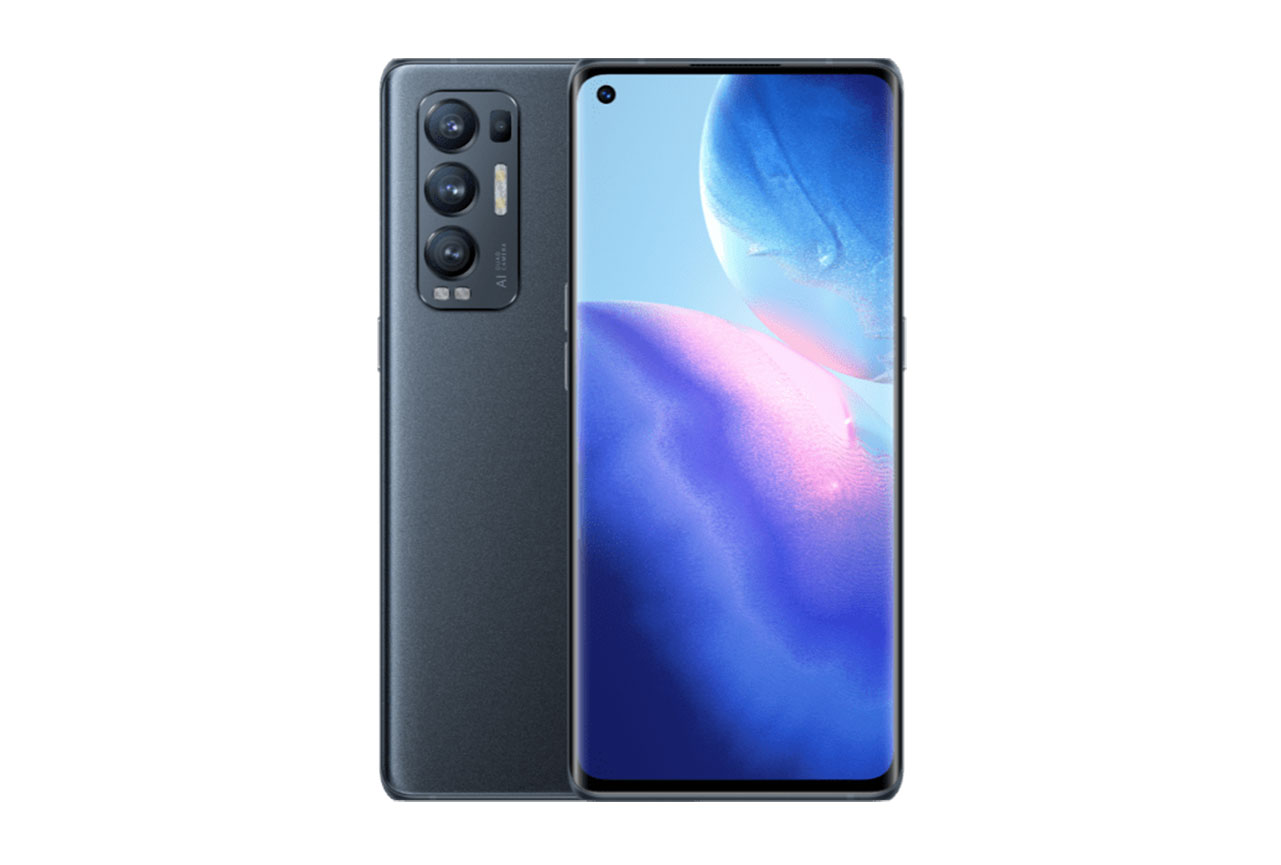 Oppo Reno5 Pro+ 5G
Oppo Reno5 Pro+ 5G


 60th
60th
 19th
19th
Pros
- Colors are quite faithful in indoor and low-light conditions.
- Brightness levels are well adapted and ensure satisfying readability indoors.
- The device shows no frame mismatches when playing video games.
Cons
- Very strong video contrast rendering makes watching HDR10 videos unpleasant.
- In outdoor conditions, image rendering is modified to improve readability, but also leads to unnatural rendering for both contrast and color.
- Lack of smoothness is noticeable when browsing or gaming.
The Oppo Reno5 Pro+ 5G’s overall score of 83 reflects a respectable, though not stellar, performance, with quite a number of other devices ahead of it in our database. Among its three competitors that we use as comparison devices in this review (the Huawei P40 Pro, the Sony Xperia 5 II, and the Xiaomi Mi 10 Ultra), only the Huawei device does better, however. Low scores in our video and touch attributes significantly impacted the Oppo’s overall score despite its fairly good results for color, motion, and control of artifacts.

Readability
Oppo Reno5 Pro+ 5G
66
76
DXOMARK uses the device’s gallery app to show static (still image) content when measuring the device’s display for brightness, contrast, gamma, and blue light impact, etc.
How easily you can see the content on your display is of paramount importance, and with 66 points, the Oppo Reno5 Pro+ 5G puts in an average performance for this attribute. While well-suited for indoor conditions, its default brightness is slightly too bright in low-light environments during daytime. However, the device adapts its brightness to the time of day and becomes appropriately dimmer at night.

Outdoors, the Oppo device lacks brightness; more seriously, however, is that the image rendering is visibly altered both in shade…

… and under direct sunlight (the other devices also struggle a bit under the same conditions).

The Reno5 Pro+ is slow to adapt to falling light conditions. Further, its image rendering is unstable in outdoor conditions, as it is too sensitive to ambient lighting variations.
Although the Oppo device loses brightness and contrast when viewed in angle, it is still readable.


Even though there are some slightly visible darker areas around the notch and close to edges, the Reno5 Pro+ is quite uniform in brightness overall. Its blue light filter (BLF) lends the device a suitable level of brightness in dark conditions.

Color
Oppo Reno5 Pro+ 5G
82
92
DXOMARK uses the device’s gallery app to show static (still image) content when measuring the device’s display for white point, gamut, uniformity, color fidelity, and blue light filter impact, etc.
Like many other smartphones, the Oppo device does not adapt its white point to the ambient lighting. In terms of color rendering, our engineers noticed a slight orange cast in several test pictures, and noted that red colors are saturated.

Under sunlight and in the shade, the Oppo Reno5 Pro+ 5G also shows a slight orange cast, and colors are not faithfully rendered.

The charts below show the Oppo Reno5 Pro+ 5G’s color reproduction fidelity when under 1000 lux lighting in both the sRGB (standard) color space (left) and the broader DCI-P3 color space (right). The center of each circle is the target color; anything outside the circle represents a noticeable color difference. The further the tip of the arrow is outside of the circle, the more a user will notice the difference between the color on the display and the color of the original source material.
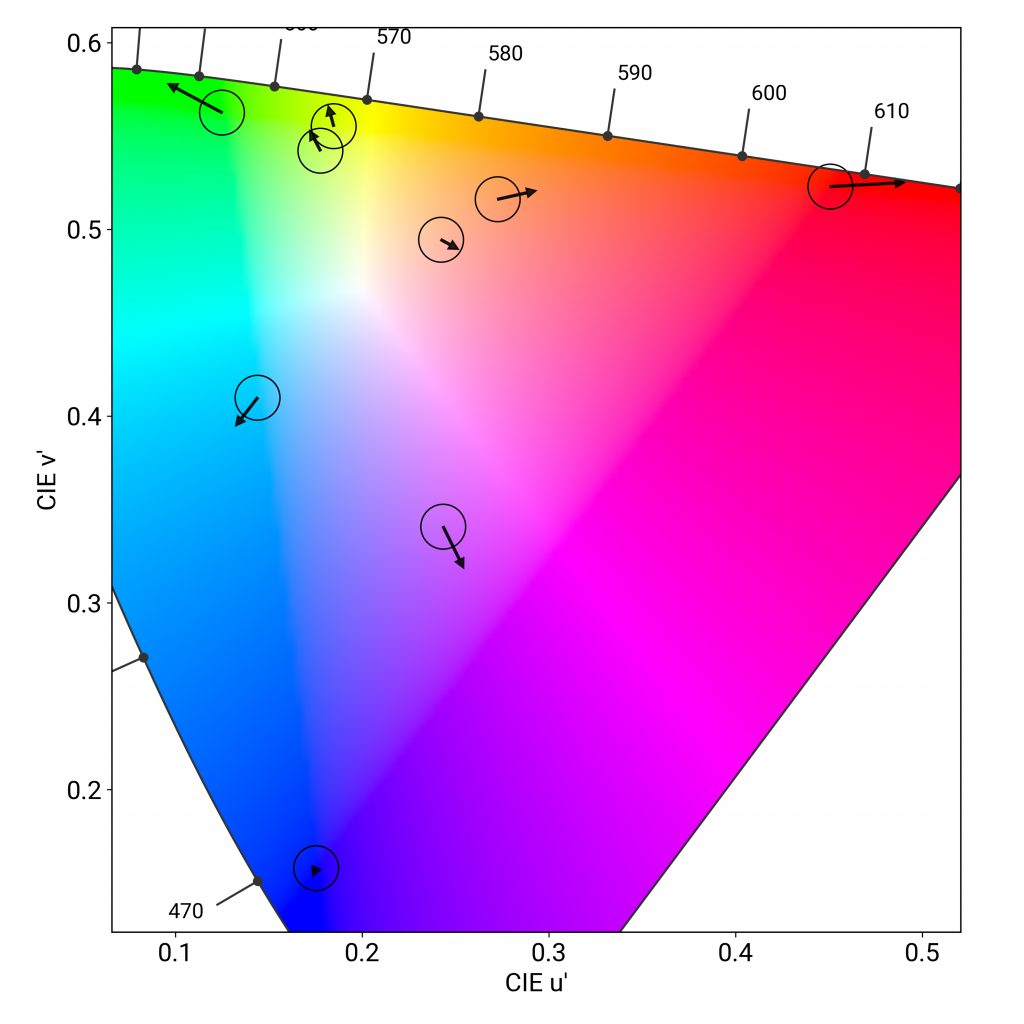

The Oppo device quickly shifts to a noticeable pink cast when viewed at an angle, as the scatter chart on the right indicates:
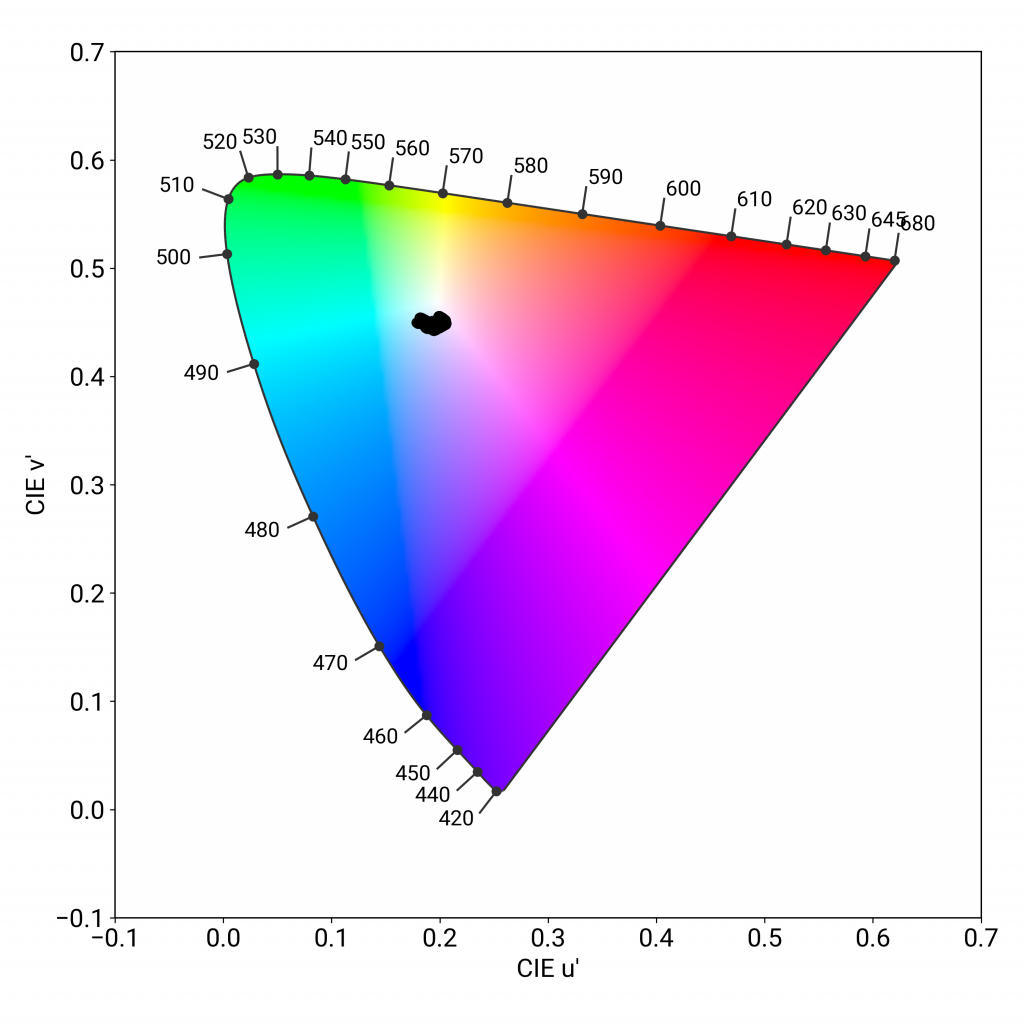

You can see that on-angle pink cast in the illustrative array below:

Though there is a little bit of visible variation, Oppo Reno5 Pro+ 5G’s display screen is quite uniform in color, particularly when compared to the Huawei and Xiaomi devices.
With the BLF turned on, the Oppo shifts to a noticeable orange cast, but its cast seems quite insignificant when compared to the strong cast of the Sony Xperia 5 II.

BLF on, left to right: Oppo Reno5 Pro+ 5G, Huawei P40 Pro, Sony Xperia 5 II, Xiaomi Mi 10 Ultra

Video
Oppo Reno5 Pro+ 5G
58
91
DXOMARK uses the device’s video (or browser) app to show dynamic content when measuring the device’s display for brightness, contrast, gamma, and color.
None of the devices in our comparison, including the Oppo Reno5 Pro+, did well in our video category; even the best of the group, the Huawei P40 Pro with 61 points, is far behind the current leader for this attribute, the Samsung Galaxy S21 Ultra 5G (Exynos) at 90 points.
As for the Reno5 Pro+, the device has slightly low brightness for HDR10 videos.


Video contrast, left to right: Oppo Reno5 Pro+ 5G, Huawei P40 Pro, Sony Xperia 5 II, Xiaomi Mi 10 Ultra
The Oppo Reno5 Pro+ 5G’s colors are too saturated and have a discernible orange cast. As can be seen in the first video photo array illustrating video brightness, skin tones are affected by this cast and appear more orange-red than they should be, which is especially true for darker skin tones.

Motion
Oppo Reno5 Pro+ 5G
82
87
The device shows some frame mismatches at 30 fps, and multiple frame mismatches at 60 fps, as you can see in the test shots below. What we look for on the 60 fps video picture in this case are the “moments” when two light gray or two dark gray squares follow each other horizontally. This means that at those points in time, the video is not being displayed as it should.


But although its lab results are somewhat under par, our engineers did not experience any frame mismatches when putting the Oppo device through our hands-on gaming tests. The Reno5 Pro+ 5G also shows some frame duplications, but its overall resulting motion is smooth. That said, when stopping and restarting video playback, there is an observable delay before the video resumes play.

Touch
Oppo Reno5 Pro+ 5G
67
85
Despite a capped zoom, the Oppo Reno5 Pro+ 5G has satisfying zoom accuracy and is smooth in the gallery app. However, the device lacks smoothness when browsing or gaming. Of arguably greater concern when gaming is that the device’s corners do not detect touches; and although touches are detected along the edges, it is harder to register touches there than in the screen’s central area.

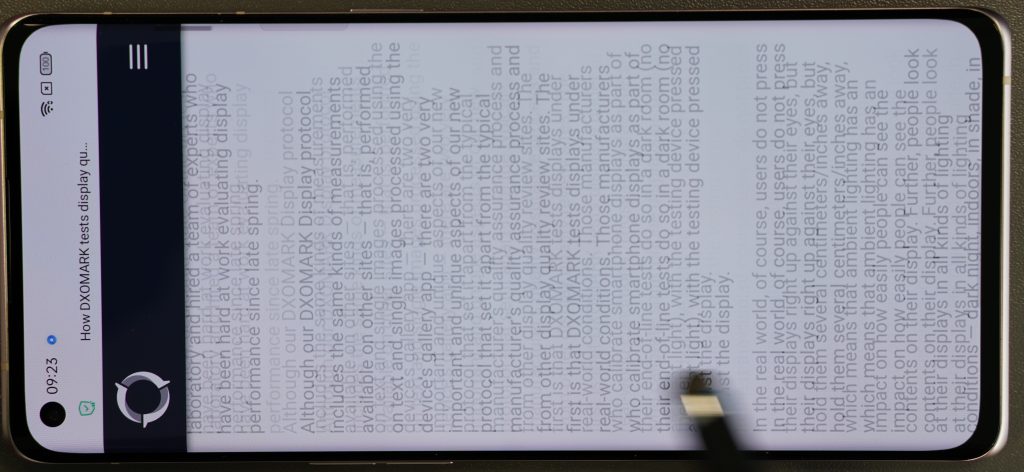

Artifacts
Oppo Reno5 Pro+ 5G
80
86
Oppo Reno5 Pro+’s mean reflectance is 4.7%; the graph below shows its reflectance curve over the visible spectrum:
The phone has a pinhole notch on the top left of the screen; though small, it may hide some content. In terms of flicker, the Oppo device is similar the Huawei P40 Pro, with a frequency of 363 Hz:
One factor that pulled down the Oppo Reno5 Pro+ 5G’s score for artifacts was that it does not manage judder well at 24 fps. (No judder is visible at 30 fps, and is just slightly visible at 60 fps.) Another factor is that the Reno5 Pro+ 5G responds to unintentional “ghost” touches; and further, aliasing is noticeable when gaming:
Some closeups:
Conclusion
The Oppo Reno5 Pro+ 5G comes with a number of high-end features that make it an attractive offering. In terms of its display performance, while landing on the low side of the middle in our Display database as a whole, the Oppo essentially tied with (and in some cases outscored) the comparison devices in this review in all attribute categories.




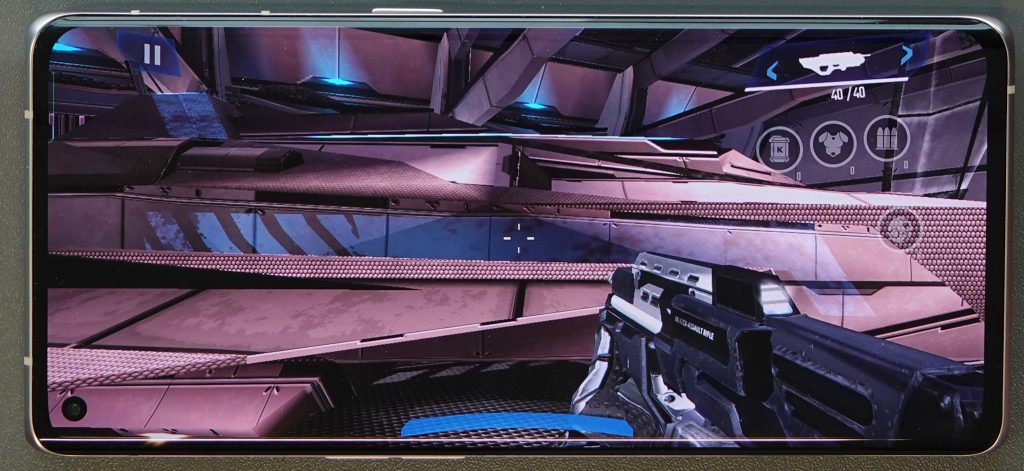



DXOMARK encourages its readers to share comments on the articles. To read or post comments, Disqus cookies are required. Change your Cookies Preferences and read more about our Comment Policy.